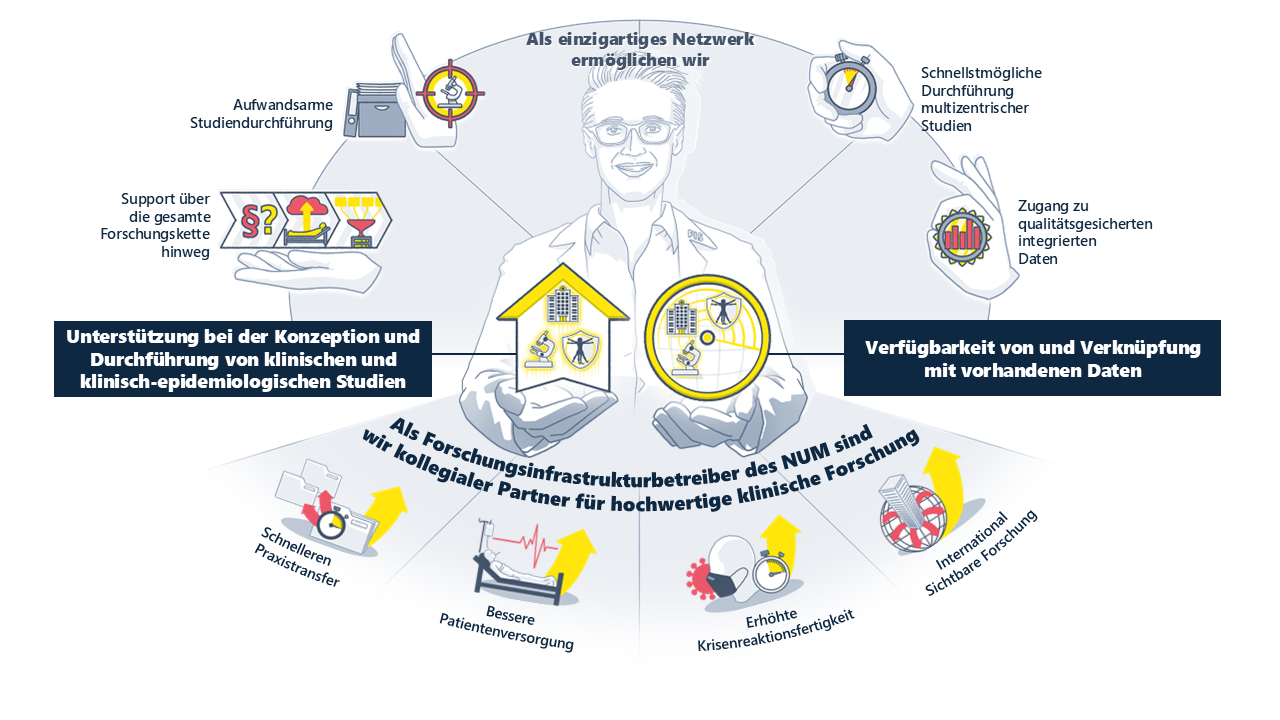Reseach Infrastructure at the NUM
NUM Reseach Infrastructures support researchers with methodological expertise, data management and high-quality research data
At the beginning of the COVID-19 pandemic, there was a widespread lack of the necessary platforms to collect and store treatment data and biosamples across institutions in a structured manner and make them available for use. For this reason, research and data infrastructures were either set up from scratch in several NUM projects (e.g. the RACOON image data platform) or existing ones were expanded (e.g. the NUKLEUS study platform).
As medical research data is extremely heterogeneous, there can be no "one size fits all" infrastructure solution for clinical research data. Accordingly, the NUM has set up Reseach Infrastructures for different types of data, different ways of obtaining data and different treatment settings. To ensure that these partial solutions complement each other optimally and are compatible at their interfaces, these platforms all work on the basis of the FAIR (Findable, Accessible, Interoperable, and Reusable) principles.
Implementation is in the hands of nationwide interdisciplinary expert networks, each of which contributes specific expertise on certain types of data (e.g. imaging data, autopsy data, emergency admission data) to NUM. The resulting NUM platforms are used by the NUM research projects and will also support researchers outside the NUM in their research projects in the future.
The NUM currently has the following Reseach Infrastructures, each with a different focus: AKTIN | NATON | NUKLEUS | NUM Study Network (NUM SN) | NUM-DIZ | RACOON | NUM-MB | Specialist Network Infections | NUM-SAR | German Biobank Network (GBN). Others will follow from 2026.
A central task of the NUM is to provide these Reseach Infrastructures in the long term and to continuously develop them further. This includes the further expansion of the NUM platforms into a Germany-wide data space for all types of clinical research data. This should be widely available for use by the scientific community in line with the open science concept.
Vision of the NUM FIS
"The Network University Medicine provides THE national research infrastructure with needs-orientated solutions for practice-changing health research. This Reseach Infrastructure creates optimal conditions for researchers, strengthens responsiveness and enables coordinated action."
Mission of NUM FIS
We operate a transparent, user-friendly and scalable infrastructure that is based on trusting collaboration and interdisciplinary expertise and provides researchers with the best possible support for multicentre collaborative projects across the entire research chain.
To this end, we provide researchers with a comprehensive portfolio of instruments, advice and services to collect high-quality research data and biosamples. We make these available to the scientific community based on the FAIR principles as well as legal, organisational and technical standardisation and harmonisation. This enables us to gain scientific knowledge that enables improved prevention and treatment of diseases and thus contributes to people's health.
A key component in realising this vision is the creation of a data room for clinical research data in Germany. In the future, this data room should contain all types of clinical research data. This applies regardless of whether it is data from routine clinical care or data collected in addition to routine documentation in clinical studies.
In order to realise this vision, the "Steering Committee of the NUM research infrastructures" was set up for the overarching management and further development of the NUM research infrastructures. It ensures that further infrastructure development is carried out by researchers for researchers and that the needs of research data users are taken into account as much as possible.













